Contact Us
Contact Details

Frequently Asked Questions
What are the fees to adopt?
As a non profit company, Wandisa receives a partial subsidy from the State but needs to charge for professional services rendered to adults to meet its operational and other expenses. Please let us know which services you require, and we will email you a Fee Schedule that gives a detailed breakdown of all costings.
What do I need to pay if I am a birth parent?
Zero. Nothing. We do not charge birth parents or children for our services.
How long does the process take?
To adopt, you need to be screened, approved and prepared. We call this first part of the process, “screening”. This usually between 1 and 4 months, depending on your availability, the scheduling of group sessions and how quickly you can get us your paperwork! That part of the process of finding the best family for a child, and then placing the child within your family, is called “matching and placement”. This varies between 1 and 18 months, depending on how open your parameters are to different children’s needs and which particular children become adoptable once you have been screened and approved.
What do we need to get started?
Drop us an email – we will send you additional information and a questionnaire to complete and return. If you decide to choose Wandisa as your professional service provider, we will include you in our next orientation session where you will meet others wanting to adopt, and our Team, who will answer any extra questions you may have.
Can a single person adopt?
Most definitely! Section 231 of the Children’s Act 38 of 2005 states that a child may be adopted jointly by a husband and wife; partners in a permanent domestic Life-Partner or other persons sharing a common household and forming a permanent family unit. A child may also be adopted singly by a widower, widow, divorced or unmarried person; a married person whose spouse is the parent of the child or by a person whose permanent domestic life partner is the parent of the child; the biological father of a child born out of wedlock; or the foster parent of the child.
What is the upper age limit for adoption?
Our Children’s Act does not contain an upper age cut-off limit for prospective adoptive parents. However, to best serve the child’s interests, it is crucial that you are fully capable of assuming all parental responsibilities. This includes being fit and proper to be entrusted with full parental responsibilities and rights in respect of the child; willing and able to undertake, exercise and maintain those responsibilities and rights; over the age of 18 years; and properly assessed by an adoption social worker for compliance with the above.
What documentation is required?
To start off with, copies of your identity documents; marriage certificate (if applicable); identifying documents of children and any adult living in your household; criminal clearances and child protection clearances for yourselves and any adult living in your household; proof of employment; statement of assets and liabilities and monthly income and expenditure; proof of address and a medical report completed by your local GP. You will also need to confirm on affidavit you have not committed any sexual offenses.
Can we meet the child first and then decide if we would like to adopt?
No – this is not an option. Instead, we give you a full overview of the child’s story, including social background, medical information, a personality description, as well as photos. You are welcome to ask additional questions at this stage. On the basis of the information provided, you either need to accept the referral, or decline the referral. It is only once you have confirmed in writing that you want to proceed that you meet the child.
How do you match a child with a family?
This is a hugely important decision and we take many things into consideration when matching a child with a family! But at all times, we are child-centered: we look at what the child needs and which family can best meet those needs. We speak to other professionals; engage with teachers and caregivers. And of course, we look at the family’s parameters, their preferences, the child’s background, and history (and how comfortable the adoptive family will be with this and with sharing this with the adoptive child). Where birth parents have chosen to be involved, we pay attention to their requests. Sometimes a short profile of the prospective adoptive parents is shared with the birth parents, where permission has been given for us to do so.
What is the best age group of a child to consider?
There is no right or wrong age group. It is important that you as a family make an informed decision about the age of child you are open to adopting, as this is of course a lifelong commitment! Because of the investigations and statutory work required before a child becomes legally available for adoption, adoption rarely happens before children are 4-5 months old. What we do know from research is that the earlier children can be placed into family care, the better their ability to adapt.
Can we apply or register at more than one organisation?
Rather choose and proceed with one organisation, to avoid duplicating the time and money you invest in this important process. Wandisa networks extensively with other organisations in respect to its screened families and in respect of children who become adoptable.
What guarantee is there that the birth mother won’t demand to have her child back/change her mind?
After being counselled as to what adoption means, the birth parent formally signs consent to adoption in front of a Magistrate in Court. Within the next 60 days, the birth parent can change his/her mind and notify the Court that consent is being formally withdrawn. If the 60 days lapse without consent being withdrawn, that consent becomes final, legal and binding.
Must the documents be certified at the police station?
They can be certified at a police station – or through any Commissioner of Oaths.
Why are certain documents only valid for 3 – 6 months after being certified?
This is so that documentation is up to date and includes any change in circumstances. We will help you by letting you know which documents need fresh certification.
Why do we need so many certified copies of our documentation?
Each stage requires certified documentation: when presenting your family to the Wandisa Team to confirm your suitability; when transferring the child into your care; when applying to the relevant province for a Section 239(1)(d) recommendation letter, and when submitting your adoption application to Court.
How many social workers are allocated per child’s case?
One social worker is primarily responsible for each child’s case, whilst being fully supervised by a senior social worker. At Wandisa, however, we value teamwork – and meet regularly to brainstorm, plan and advocate for what is best for each child.
Why is a home visit needed?
A home visit is needed to physically verify your address and your home circumstances, which must be included in your suitability report. We love these visits because they give us the the opportunity of connecting with your children and members of your household!
Does Wandisa apply for the child’s new birth certificate after adoption?
No – as the adoptive parents, you will be given the child’s Order of Adoption and original birth certificate. It is then up to you to apply to the Registrar of Adoptions to register the adoption and to thereafter apply for the noting and name changes through your local Department of Home Affairs. We will provide you with a detailed step-by-step process guide and contact information to help you.
How long after the first meeting do, we have to wait before taking the child home with us?
You will only meet your child once there is a court or transfer of care order in place. The bonding and transition period depends on the child’s age, personality, and respective care home. We move at the child’s pace. The usual transition period is 1-7 days, taking into account how the child is adapting, how you are coping and feedback from the caregivers at the home.
After the matching process, how long before we can meet our child?
This varies depending on who is in the driver’s seat! We are directly responsible for some children and collaborate with social work organisations to help other children all over South Africa. Once you have been matched with a child and accept that referral, you could wait anywhere from 1 week to 4 months for a court date to be allocated or the relevant Department of Social Development to authorise the child’s transfer of care to you. There are certain things we cannot control, but we do follow up regularly, knowing that every day counts.
Why does the court require original documentation and copies?
As adoption is legal, binding and final in a child’s life, it is important the Court be furnished with original and certified documentation for verification purposes.
Do we need to meet the birth parents?
No – but some birth parents do request this and if you are not willing to do so, this may prevent you from being considered to parent that child. Because we understand the positive aspects of children knowing their life story, where appropriate, we encourage families to research open adoption and discuss with us their attitude to different kinds of openness after adoption.
When a child is abandoned, how do you know the medical history?
We do not always know the medical history of abandoned children. However, where a birth parent safely hands over a baby for care, the first professional to respond tries to get as much information as possible on the child and birth family. Where a child is abandoned in hospital, it is usually possible to obtain the mother’s and child’s records. Sometimes a parent will leave the child’s Road to Health card which contains vital information. We try as hard as we can to find out as much as we can, but sadly where children are unsafely abandoned or abandoned without any form of identification or paperwork, no medical history will be known. This is one of the reasons we insist on each child being assessed by specialist doctors, on bloodwork being done as soon as possible and getting all findings in writing.
How is a child’s adoptability determined?
Not every child in a children’s home, or without a parent or parents, is adaptable. Adoption can only take place where this is best for the child, the child is legally available for adoption and all provisions of the Children’s Act have been met. Adoptability includes where:-
(a) the child is an orphan with no guardian/caregiver willing to adopt the child;
(b) the whereabouts of the child’s parent/guardian cannot be established;
(c) the child has been abandoned;
(d) the child’s parent/guardian has abused or deliberately neglected the child, or has allowed the child to be abused or deliberately neglected;(e) the child is in need of a permanent alternative placement;
(f) the child is the step-child of the person intending to adopt; or
(g) the child’s parent/guardian has consented to the adoption unless consent is not required.
There are additional requirements to be met, such as taking into account the rights and responsibilities of both the birth mother and birth father and obtaining formal consent from each of them where this is necessary. In cases of abandonment or where the whereabouts of an identified parent are unknown, Wandisa™ must advertise in a local newspaper for that person or any other family member to come forward. If no one comes forward within 90 days, the application can be made for the child to be declared adoptable.
Who looks after children placed into BabySavers?
Wandisa responds immediately to call-outs. After ensuring the baby is checked by medical professionals, we ask one of our screened and approved temporary safe care (“TSC”) parents to be on standby. We then go to court with the baby and that family for a Court Order that Wandisa takes formal (statutory) responsibility for the child and for the TSC parents to take physical care of the child. The Wandisa Team then gets cracking with a full investigation into the circumstances of the child and birth family and makes a professional recommendation to the Court as to what should happen to the child going forward.



